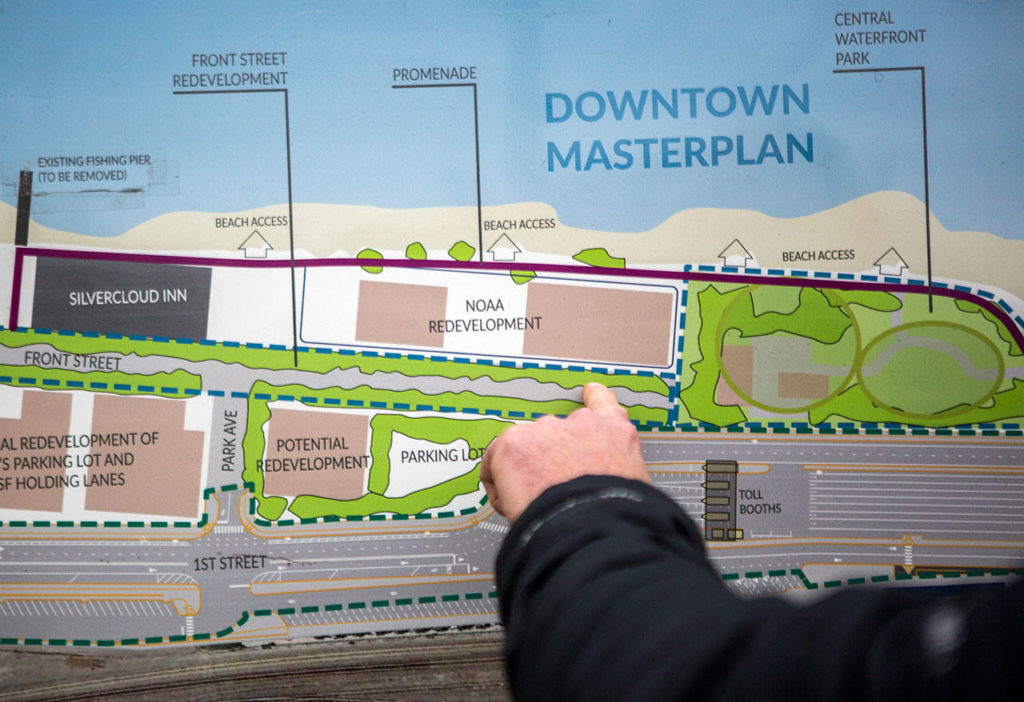From the outside, the weathered two-story structure looks haunted.
Inside, it’s even creepier.
Not many looky-loos get in, though. The doors are locked and barbed wire tops chain-link fences.
What’s up with that?
That mysterious eyesore by the sea is Northwest Fisheries Science Center’s Mukilteo Research Station, a fancy name for a lab.
“The fact that it looks a little scary prevents people from knocking on the door. It’s like, ‘Ah, that’s probably a meth lab,’” joked station chief Paul McElhany.
It’s more a crab lab: Sea organisms are grown in saltwater for experiments.
Instead of the blue crystals from “Breaking Bad,” they’re cooking up carbon dioxide and crab larvae, for the good of the planet.
The former World War II Air Force barrack is a maze of rooms with microscopes, bubbly tubs of water and a display case of dusty crab shells. It is drafty and creaky with crooked floors. The grounds are strewn with years of discarded pipes and junk.
The 1-acre spread on Front Street is next to the Silver Cloud Inn where rooms start around $200 a night. A thick row of trees blocks it from the view of hotel guests, most with no inkling of what lurks inside.
The building is near the ferry vehicle holding lot and two doors down from Ivar’s. It wasn’t as noticeable before the waterfront makeover that includes a new terminal, holding lanes and promenade.
Now it stands out in the massive construction area, and will only get more visible. Ultimately, in a good way.
“It’s all going to go,” McElhany said of his compound with a crusty pier and a boneyard where old experiments and parts go to die.
Demolition is slated for mid-2020, about the time projects around it will be nearing completion. Design and permits are in the works.
Final funding was recently approved for a new modern $40 million research facility slated to open in 2022. It will allow public access. You’ll want to go in.
The station “makes critical investment in the nation’s capacity to advance cutting-edge research on marine wildlife and their habitat as well as ocean acidification,” Rep. Rick Larsen wrote in a press release applauding the funding.
The Air Force earlier transferred the property to the National Oceanic and Atmospheric Administration, NOAA, which oversees the Mukilteo station. Other holdings by the Air Force’s 40-acre spread went to the city of Mukilteo, WSDOT, Tulalip Tribes and Port of Everett for the new ferry terminal, parking lots and development.
“We got our little 1.1 acre,” McElhany said.
The Mukilteo research center has worked out of the barrack since the 1970s.
“The Air Force owned the property and they weren’t using it, so they never fixed it up,” McElhany said. “NOAA was using it, but didn’t own it so they didn’t fix it up. So it has been held together with bits of research money.”
The foundation has been bolstered by temporary supports.
“Five or six years ago, to stabilize the building they put in over 100 of these shore jacks underneath to keep the building from settling anymore,” McElhany said. “They couldn’t straighten it because that would break something even worse. This is holding it in place.”
Even so, at one point the vibrations from heavy construction nearby forced the station to close for a week.
McElhany leads the research on the effect of changes in ocean chemistry caused by carbon dioxide, aka CO2.
Stuff like this: At night, surface light traps catch crab larvae for experiments. “Like floating Japanese lanterns,” he said.
“We put the animals we catch in the light traps into seawater that we’ve added CO2 to mimic the amount of acidification we expect several decades into the future. The CO2 that gets into the ocean comes from the burning of fossil fuels.”
Research is also done on female crabs with eggs that when hatched are reared through varying CO2 treatments. Those crabs come from traps or from divers.
The crabs used in experiments are devoted to science, not for dinner for the team of researchers.
The center is also used by ecotoxicology scientists to study the effects of oil and urban runoff. “The early work on the Exxon Valdez oil spill happened here,” McElhany said.
During construction, his research will continue at NOAA’s Montlake lab in Seattle and the Manchester station in Port Orchard.
The view across Puget Sound to Whidbey Island from McElhany’s second floor office is through peeling window frames.
“It will be hard to give up the character,” he said. “I grew up in the country and it reminds me of barns I worked in.”
It looks out to a pier, where researchers set traps to catch crab larvae and an intake water line pumps seawater into tanks for experiments.
In the new building, the water system will be automated and underground. Gone will be the rickety pier, rusty storage tanks and tangled mess of hoses and cords in the labs with bubbly tubs.
“It will be exciting not to have the building itself be one of the challenges of research,” McElhany said.
Andrea Brown: abrown@heraldnet.com; 425-339-3443. Twitter @reporterbrown.
Talk to us
> Give us your news tips.
> Send us a letter to the editor.
> More Herald contact information.





























